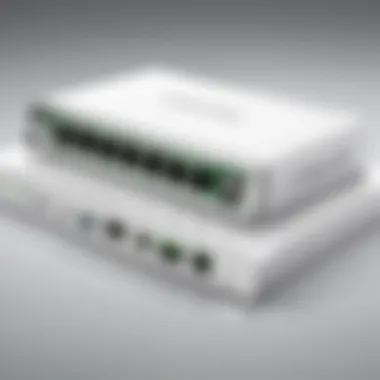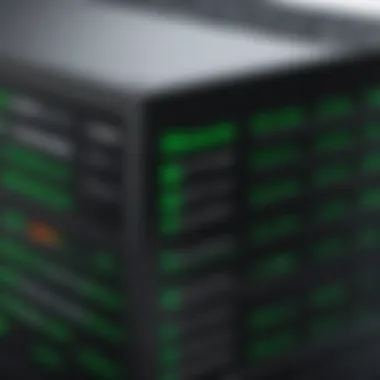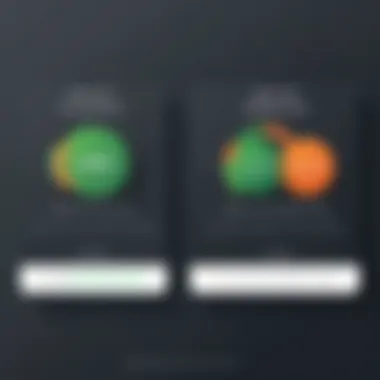Decoding Meraki Firewall Pricing: A Comprehensive Guide


Intro
In today’s fast-paced digital landscape, network security is a critical concern for businesses of all sizes. As organizations increasingly rely on cloud services and remote connectivity, the importance of a robust firewall becomes undeniable. Meraki firewalls have gained recognition for their cloud-managed approach, offering ease of use alongside powerful security features. However, understanding the pricing structure can be challenging. This article aims to unravel the intricacies of Meraki firewall pricing, providing insights into various factors influencing costs.
Features Overview
Meraki firewalls are equipped with a range of functionalities designed to protect networks effectively. Understanding these features is essential for evaluating their pricing and overall value.
Key Functionalities
Some of the key functionalities include:
- Advanced Threat Protection: Real-time threat intelligence helps identify and mitigate attacks.
- Content Filtering: Organizations can block inappropriate websites, enhancing productivity and security.
- VPN Capabilities: Secure remote access for employees is crucial, and Meraki provides robust VPN options.
Additionally, Meraki functions rely on cloud management, simplifying network configuration and monitoring. This reliance on a centralized platform can differ from traditional firewalls and impacts overall pricing.
Integration Capabilities
Integration with existing systems is another vital aspect of Meraki firewalls. These devices work seamlessly with other Cisco products and third-party applications. Such compatibility allows for:
- Simplified Deployment: Quick and straightforward installation without extensive disruption.
- Centralized Management Interface: One interface for managing multiple network components, reducing administrative overhead.
Furthermore, Meraki’s API allows for customization, enabling organizations to tailor security to their specific needs. This level of flexibility is a significant factor in the pricing model.
Pros and Cons
Like any technology, Meraki firewalls come with their set of advantages and disadvantages.
Advantages
- Scalability: Organizations can easily scale their security as they grow.
- User-Friendly Interface: The intuitive dashboard simplifies management for IT staff.
- Regular Updates: Continuous improvements from Cisco enhance security and functionality.
Disadvantages
- Subscription Costs: The reliance on a subscription model can lead to ongoing expenses that may add up.
- Dependence on Internet: Cloud management requires stable internet access. Any disruptions can affect monitoring and security.
- Limited on-premise options: For businesses that prefer or require onsite solutions, Meraki may not be the best fit.
Understanding these elements is crucial for making informed decisions regarding Meraki firewalls. A comprehensive analysis of their features, pros, and cons can guide businesses in terms of investment and security needs.
Culmination
In summary, Meraki firewall pricing is influenced by various factors, including feature offerings, integration potential, and subscription models. By comprehending these aspects, businesses can better assess their options. This analysis aims to empower decision-makers with knowledge to navigate the evolving landscape of network security.
Overview of Meraki Firewalls
The overview of Meraki firewalls is crucial in understanding their role and functionalities in network security. Meraki, a Cisco brand, has made a name for itself by offering a range of cloud-managed networking solutions. This includes their firewalls, which are designed to protect an organization’s network from internal and external threats. They simplify network management with features that are easy to deploy and manage, appealing particularly to businesses lacking extensive IT resources.
Intro to Meraki
Meraki's approach integrates cloud management with networking hardware. The company promotes its products as intuitive and user-friendly, aiming to reduce complexity in network setup and oversight. Users can manage the network through a centralized dashboard, which allows for easier monitoring and configuration of firewall settings. This is especially important for businesses that require quick adjustments based on changing security landscape.
Features of Meraki Firewalls


Meraki firewalls come loaded with various features that enhance security and simplify management. Key features include:
- Advanced Threat Protection: They offer protection against malware, intrusion attempts, and data exfiltration. This is enhanced by their integrated security intelligence that updates in real time.
- Content Filtering: Administrative control is provided through tools that can restrict access to certain types of web content, helping maintain compliance and network integrity.
- VPN Support: Remote access is crucial for modern businesses. Meraki firewalls support site-to-site and client VPN configurations, ensuring employees can securely connect from various locations.
- Ease of Use: The web-based interface provides straightforward navigation, enabling even non-technical staff to manage network policies effectively.
Benefits of Using Meraki Firewalls
Deploying Meraki firewalls comes with several benefits that cater specifically to the operational needs of businesses. These include:
- Scalability: As businesses grow, their networking needs change. Meraki firewalls allow for easy upgrades and expansions without significant overhauls in existing infrastructure.
- Cost-Effectiveness: While initial hardware investments exist, the long-term subscription models can lead to significant savings, especially when factoring in lower IT overhead.
- Enhanced Visibility: Monitoring tools offer insights into network performance and security incidents. This allows for proactive management and quicker response times to potential threats.
- Community Support: As part of the broader Cisco ecosystem, Meraki benefits from a robust community, including forums and documentation that provide resources for troubleshooting and learning.
"Meraki revolutionizes the way businesses think about network security, providing tools that are both powerful and accessible."
This section lays the foundation for understanding the pricing structure, as it highlights the essential attributes that must be considered when investing in Meraki firewalls.
Pricing Models of Meraki Firewalls
Understanding the pricing models of Meraki firewalls is crucial for any organization looking to invest in network security. This section will detail how pricing impacts the total cost of ownership, compliance with operational needs, and alignment with financial strategy. By paying attention to the pricing structure, businesses can effectively assess the investment not just in terms of initial outlay but also in ongoing costs and financial commitments.
Overview of Pricing Structure
The pricing structure for Meraki firewalls is designed to be transparent and straightforward. It aims to avoid confusion that can arise from more complex pricing models. Generally, there are two main components to consider: one-time hardware costs and recurring subscription fees.
These costs are influenced by various factors, such as the size of the deployment and the number of features being utilized.
- Hardware Costs: This refers to the initial investment in purchasing the firewall devices. The costs can vary depending on the models selected and the specific requirements of the business.
- Subscription Fees: These are ongoing costs that provide access to software features, support, and updates.
Together, these elements create a comprehensive pricing landscape that businesses must navigate. Understanding this structure is essential for clear financial planning.
One-Time Hardware Costs
One-time hardware costs are the initial purchase price of the Meraki firewall models. This encompasses the physical devices themselves, which will act as the first line of defense in an organization’s network security. The cost can range based on several factors, including the model selected and the capacity required.
- Example Models: Meraki MX series firewalls cater to different needs, from small office setups to large enterprise environments.
- Capacity Considerations: The requirements for throughput and the number of users significantly impact the hardware cost.
Investing in the appropriate hardware is vital, as it directly affects the performance and capabilities of the firewall. It's wise to assess future scalability when deciding on models.
Subscription Fees Explained
Subscription fees are a recurring cost necessary for the operation of Meraki firewalls. These fees typically cover software licenses for updates, access to cloud management features, and customer support.
The subscription model can often provide benefits like:
- Streamlined Management: Cloud-based management makes it easier for IT teams to monitor and control network security.
- Regular Updates: Ensuring the firewall software is always up to date helps mitigate vulnerabilities.
- Access to New Features: Subscribers gain access to new security features and enhancements as they are released.
Businesses need to consider the length of the subscription, as longer commitments may provide savings. Regular evaluation of the subscription terms can lead to cost optimizations over time.
"Understanding pricing models is essential for organizations to align their network security investments with their financial strategy."
Navigating the pricing models of Meraki firewalls sheds light on both the upfront and ongoing costs that impact the overall investment, empowering organizations to make informed decisions.
Factors Influencing Meraki Firewall Prices


Understanding the factors that influence Meraki firewall prices is crucial for organizations evaluating their network security options. Each factor, from deployment types to the number of users and available features, affects overall pricing in unique ways. Recognizing these elements will help businesses allocate budgets effectively and ensure that they invest in solutions tailored to their specific needs.
Type of Deployment
The type of deployment chosen for a Meraki firewall can significantly impact its pricing. Organizations have several options: cloud-based deployments provide flexibility but may incur differences in costs compared to on-premise installations.
- Cloud-Based Deployment: This option offers scalability and ease of management. The pricing often reflects a subscription model, where costs can increase based on usage and the number of connected devices.
- On-Premise Deployment: While this may entail higher initial hardware costs, it can lead to lower long-term expenses. Organizations retain full control over their hardware and networking configurations.
Each deployment carries its advantages and budget considerations. Understanding these can help organizations choose the right infrastructure while balancing performance requirements and costs.
Number of Users and Devices
The user and device count is another vital consideration when assessing Meraki firewall pricing. The number of users, devices, and network segments directly correlates to the resources required and, consequently, the costs incurred. Larger organizations typically face higher costs necessitated by:
- Increased Bandwidth Needs: More users mean greater demand for bandwidth, which can lead to the necessity for enterprise-grade solutions.
- Licensing Models: Meraki’s licensing often scales based on usage. Larger deployments might require different pricing tiers, impacting the overall budget incurred by the organization.
Evaluating potential growth in the number of users or devices helps organizations plan effectively. This anticipation allows thoughtful budgeting and avoids unexpected costs as needs evolve.
Feature Sets
The feature sets of Meraki firewalls also play an influential role in determining pricing. Depending on organizational requirements, adding advanced capabilities or security features can range from modestly priced to premium tiers. Key aspects include:
- Basic vs. Advanced Features: Basic packages may provide fundamental firewall services, while advanced features such as intrusion prevention systems, advanced malware protection, and content filtering add to overall costs.
- Customization Possibilities: Businesses may require tailored solutions to meet unique operational demands. Customization, while beneficial, may also impact pricing.
In the end, organizations must assess which feature sets are essential for their network security and consider the cost-benefit ratio of investing in advanced capabilities versus maintaining basic protection.
"Understanding these factors can empower organizations to make informed decisions about their firewall investments."
By thoroughly analyzing deployment types, user counts, and feature sets, organizations are better equipped to navigate Meraki firewall pricing effectively.
Comparative Pricing Analysis
Understanding the comparative pricing analysis of Meraki firewalls is pivotal for organizations evaluating their network security options. This section examines how Meraki stacks up against its competitors and assesses its overall value for money. By analyzing various offerings, users can make informed decisions tailored to their specific needs.
Meraki vs. Competitors
In the current cybersecurity landscape, numerous firewall solutions are available. Meraki firewalls gain attention for their user-friendly interface and integrated cloud management. Competitors, such as Fortinet, Palo Alto Networks, and Cisco, present alternative features and pricing models.
When comparing Meraki with these competitors, one must consider the following factors:
- Ease of Use: Meraki's dashboard is highly intuitive, allowing IT teams to manage settings without deep technical knowledge. This contrasts with some competitors that may have steeper learning curves.
- Feature Set: While Meraki offers a robust set of features, competitors like Palo Alto Networks might offer advanced capabilities geared toward larger enterprises or specific compliance requirements.
- Performance: Evaluating throughput and latency is essential. Some alternative firewalls may excel in high-performance scenarios.
- Pricing: Meraki tends to use a subscription model that combines hardware and software whereas others might have a one-time hardware purchase, leading to different long-term cost implications.
The overall decision may hinge on the alignment of the firewall's functionalities with an organization's unique needs and budget constraints.
Value for Money Assessment
A critical consideration in the purchasing process is the value for money that Meraki firewalls provide. Value for money integrates both feature assessment and pricing structure. To analyze this:
- Total Cost of Ownership: This includes both initial and ongoing costs like subscription fees, hardware replacements, and potential scalability needs. Not considering these factors may distort the perception of value.
- Return on Investment: Assessing how a Meraki firewall contributes to improved security and operational efficiency can clarify its value. Organizations should calculate potential cost savings from avoiding breaches or downtime.
- Customer Support and Resources: Meraki offers extensive support avenues, which can significantly ease implementation and maintenance burdens. Reliable customer service can justify initial costs.
- Scalability: As companies grow, their network needs change. Meraki’s cloud-based infrastructure allows for easier scalability. This flexibility may represent higher value than fixed solutions from competitors.
"Choosing the right firewall isn't just about costs but how it integrates with your overall IT architecture."


In summary, a thorough comparative pricing analysis involves dissecting Meraki's position against rivals while ensuring the assessed value correlates with specific organizational goals. By methodically weighing features, support, and the cost-benefit balance, one can arrive at a justified purchasing decision.
Common Pricing Questions and Answers
Understanding pricing for Meraki firewalls involves navigating several key questions. This section will address the most frequently asked inquiries. By answering these questions, readers can gain clarity on what they can expect when evaluating costs. An informed decision will enhance their network security investments. This comprehension is crucial given the complexity of pricing structures in the IT landscape.
What is included in the subscription?
The subscription for Meraki firewalls typically covers multiple crucial elements. First and foremost, it includes all software features and updates. This means that users will always have access to the latest security measures and improvements without additional costs.
Also, technical support is included with the subscription. This offers users peace of mind, knowing that expert help is just a call away if they encounter issues. Additionally, users receive access to the dashboard, a cloud-based management tool that allows for centralized control of network operations. The dashboard facilitates monitoring and managing all network devices in real time, ensuring a streamlined approach to network security.
It's important to note that not all features are available with every subscription tier. Therefore, businesses should carefully assess their needs to choose the appropriate level.
Are there discounts for longer commitments?
Yes, Meraki does provide discounts for longer subscription commitments. Typically, organizations can save a significant amount when they opt for a multi-year subscription instead of renewing annually. This savings can make a noticeable difference in overall costs, especially for larger enterprises with multiple firewall units.
When businesses choose longer terms, they also benefit from predictability in budgeting. This stability helps organizations allocate resources more effectively without worrying about unexpected price hikes each year. Longer commitments allow for comprehensive network planning and investment in additional features that enhance security measures.
How does licensing work?
Licensing for Meraki firewalls is structured around the subscription model. Each hardware device requires a license, and this license is linked to the subscription plan chosen by the user. Typically, businesses must renew the license periodically, often annually or bi-annually.
The licensing process is relatively straightforward. Organizations purchase licenses based on their specific needs, which can be adjusted as they grow. If a company anticipates fluctuations in the number of users or devices, they can scale their licenses accordingly. This flexibility allows organizations to remain agile in their operations, adapting as necessary to meet evolving security needs.
Case Studies and Testimonials
Success Stories
Success stories illuminate the effectiveness of Meraki Firewalls across diverse business settings. For instance, consider a medium-sized enterprise that shifted to a Meraki solution to enhance their network security framework. After deploying the Meraki MX series, the enterprise reported a reduction in security incidents by nearly 40% within the first quarter of implementation. This significant decrease was attributed to the powerful security features and intuitive management interface that Meraki provides.
Furthermore, another case involved a large-scale educational institution. They faced challenges with maintaining network security across multiple campuses. By investing in Meraki firewalls, the institution found an affordable, scalable solution that integrated seamlessly with their existing infrastructure. Administrators noted a notable improvement in network performance and usability, which directly correlated with positive feedback from staff and students alike.
In these instances, the strategic investment in Meraki products not only enhanced security but also proved cost-effective in the long run. The success stories emphasize the potential return on investment and align closely with the pricing discussions earlier in this article.
Feedback from IT Managers
Insights from IT managers present a crucial perspective on the value of Meraki Firewalls. Many report high satisfaction with both the pricing structure and the overall functionality of the products. For example, an IT manager from a retail company stated, "The transparency in pricing and the scalability of Meraki solutions made our decision much easier. We felt confident that we were paying for exactly what we needed, and nothing more."
Feedback often highlights the ease of use associated with Meraki's interface. Several managers have commented on how quickly they could train their teams to manage the systems effectively, which translates to lower operational costs and higher productivity.
Despite the positive experiences, some testimonials reflect concerns about ongoing subscription fees. One IT manager expressed, "While the hardware costs were manageable, the recurring fees can add up. However, when considering the support and updates that come with the subscription, we're still happy with the value."
This candid feedback serves not only to inform prospective buyers but also underscores the importance of assessing total cost of ownership when evaluating Meraki products. The nuanced perspectives of IT managers help illustrate the broader picture of Meraki Firewall pricing and its implications for business decisions.
Epilogue
In this article, we have systematically explored the intricacies of Meraki firewall pricing. We focused on several components: initial hardware costs, ongoing subscription fees, and various factors that influence these prices. Each of these elements plays a crucial role in determining the overall expense of deploying Meraki solutions for network security.
Final Thoughts on Pricing
Understanding the pricing structure is of utmost importance for any organization considering Meraki firewalls. The subscription model offers flexibility, aligning your budget with specific needs and overall business goals. This allows for better financial planning and resource allocation.
Furthermore, organizations should consider the long-term benefits that Meraki provides, such as enhanced security, ease of management, and comprehensive cloud integration. These factors often justify the costs. When evaluating Meraki firewalls, it's also essential to factor in any additional features that may enhance security and performance but may come at an extra cost.
Finally, as businesses deliberate over their network security investments, clear comprehension of Meraki pricing can lead to more informed decisions. The initial investment in hardware coupled with the recurring subscription model should be viewed as a strategic move towards safeguarding valuable data.
"An informed choice in network security investments can lead to significant long-term gains in operational efficiency and peace of mind."





